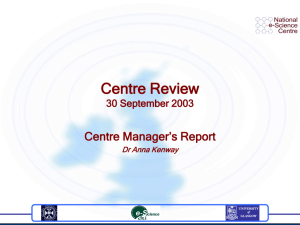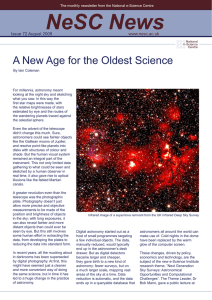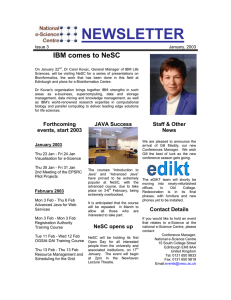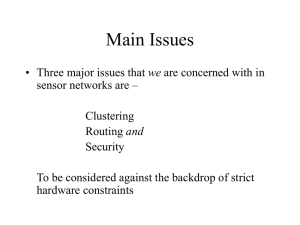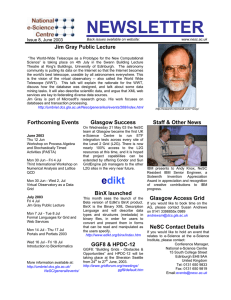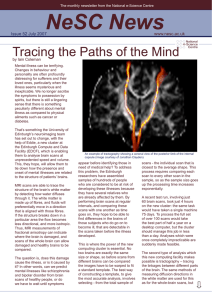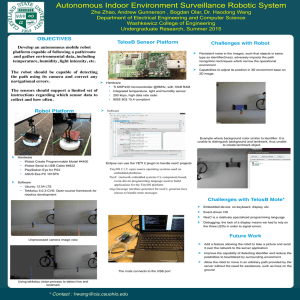NeSC News Issue 74 October 2009 www.nesc.ac.uk
advertisement
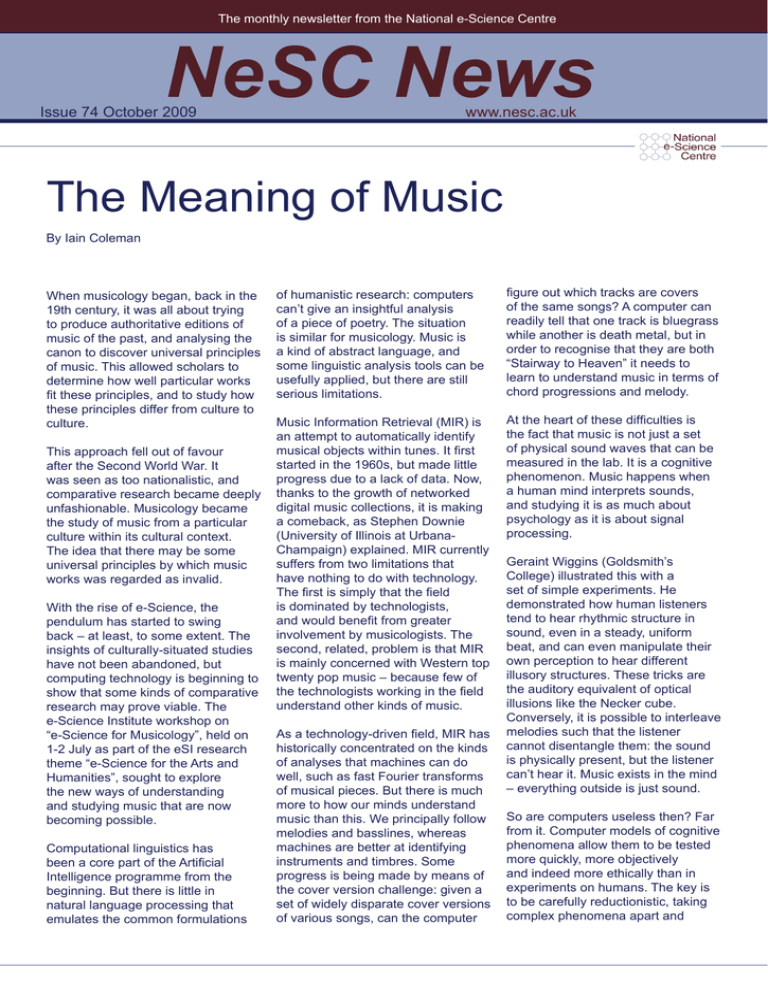
The monthly newsletter from the National e-Science Centre NeSC News Issue 74 October 2009 www.nesc.ac.uk The Meaning of Music By Iain Coleman When musicology began, back in the 19th century, it was all about trying to produce authoritative editions of music of the past, and analysing the canon to discover universal principles of music. This allowed scholars to determine how well particular works fit these principles, and to study how these principles differ from culture to culture. This approach fell out of favour after the Second World War. It was seen as too nationalistic, and comparative research became deeply unfashionable. Musicology became the study of music from a particular culture within its cultural context. The idea that there may be some universal principles by which music works was regarded as invalid. With the rise of e-Science, the pendulum has started to swing back – at least, to some extent. The insights of culturally-situated studies have not been abandoned, but computing technology is beginning to show that some kinds of comparative research may prove viable. The e-Science Institute workshop on “e-Science for Musicology”, held on 1-2 July as part of the eSI research theme “e-Science for the Arts and Humanities”, sought to explore the new ways of understanding and studying music that are now becoming possible. Computational linguistics has been a core part of the Artificial Intelligence programme from the beginning. But there is little in natural language processing that emulates the common formulations of humanistic research: computers can’t give an insightful analysis of a piece of poetry. The situation is similar for musicology. Music is a kind of abstract language, and some linguistic analysis tools can be usefully applied, but there are still serious limitations. figure out which tracks are covers of the same songs? A computer can readily tell that one track is bluegrass while another is death metal, but in order to recognise that they are both “Stairway to Heaven” it needs to learn to understand music in terms of chord progressions and melody. Music Information Retrieval (MIR) is an attempt to automatically identify musical objects within tunes. It first started in the 1960s, but made little progress due to a lack of data. Now, thanks to the growth of networked digital music collections, it is making a comeback, as Stephen Downie (University of Illinois at UrbanaChampaign) explained. MIR currently suffers from two limitations that have nothing to do with technology. The first is simply that the field is dominated by technologists, and would benefit from greater involvement by musicologists. The second, related, problem is that MIR is mainly concerned with Western top twenty pop music – because few of the technologists working in the field understand other kinds of music. At the heart of these difficulties is the fact that music is not just a set of physical sound waves that can be measured in the lab. It is a cognitive phenomenon. Music happens when a human mind interprets sounds, and studying it is as much about psychology as it is about signal processing. As a technology-driven field, MIR has historically concentrated on the kinds of analyses that machines can do well, such as fast Fourier transforms of musical pieces. But there is much more to how our minds understand music than this. We principally follow melodies and basslines, whereas machines are better at identifying instruments and timbres. Some progress is being made by means of the cover version challenge: given a set of widely disparate cover versions of various songs, can the computer Geraint Wiggins (Goldsmith’s College) illustrated this with a set of simple experiments. He demonstrated how human listeners tend to hear rhythmic structure in sound, even in a steady, uniform beat, and can even manipulate their own perception to hear different illusory structures. These tricks are the auditory equivalent of optical illusions like the Necker cube. Conversely, it is possible to interleave melodies such that the listener cannot disentangle them: the sound is physically present, but the listener can’t hear it. Music exists in the mind – everything outside is just sound. So are computers useless then? Far from it. Computer models of cognitive phenomena allow them to be tested more quickly, more objectively and indeed more ethically than in experiments on humans. The key is to be carefully reductionistic, taking complex phenomena apart and Issue 74, October 2009 The Meaning of Music What do you know about e-Research? Continued By Iain Coleman studying them one piece at a time. This approach is commonplace in the sciences, but at odds with the holistic approach usually employed in the humanities. One area in which the humanities undoubtedly benefit from e-Science is the creation of digital libraries. A great deal of scholarship is about engaging very closely with the literature. For musicologists, a lot of scholarship is literature based, so the same advantages apply. But musical materials – scores and recordings – have only recently begun to be available. Technology is opening up new possibilities for musicology: new ways of studying musical history, new relationships between pieces of music, and new insights into the musical role of the mind. With scholars and scientists working together, the potential for understanding the role of music in our lives has never been greater. OMII-UK are looking for volunteers to fill in a ten-minute survey. Slides from this event can be downloaded from http://www.nesc. ac.uk/esi/events/996/ Find the survey here: www.tinyurl. com/y9g9z29 BalticGrid-II 3rd All-Hands Meeting Poznan, Poland. Photo by Mohylek Digital editions allow scholars to ask new kinds of questions, as Richard Lewis (Goldsmith’s College) explained. Whereas traditional musicology which involves close reading of a few pieces of music, digital editions allow the large-scale analysis of hundreds or thousands of pieces of music, all at the same time. They also allow a much more expansive and flexible presentation of material. Editors no longer need to relegate explanatory information to introductions or footnotes in order to make an edition clear for performers: editions can be used in different ways by different types of reader. This flexibility, however, does come at a cost, according to Raffaele Viglianti (King’s College London). Editors need to extend their repertoire beyond their traditional roles of selection and interpretation, to encompass writing code for the digital presentation. Here, music presents its own technological challenges. XML is becoming the standard for literary philology, but it doesn’t allow overlapping hierarchies – and music is full of these. Thus, digital musicologists also need to master the hacks and workarounds that allow them to make their tools fit their studies. Completing the survey not gives you the chance to win an Amazon voucher, it also means that you will be directly contributing to development of the software and support that is needed by the research community. The third BalticGrid-II All Hands meeting will be held in Poznań, Poland, on December 9-10, 2009. The BalticGrid Second Phase (BalticGrid-II) project began on May 1, 2008. It aims to increase the impact, adoption and reach, and to further improve the support of services and users of the recently created e-Infrastructure in the Baltic States. This will be achieved by an extension of the BalticGrid infrastructure to Belarus; interoperation of the gLite-based infrastructure with UNICORE and ARC based Grid resources in the region; identifying and addressing the specific needs of new scientific communities such as nano-science and engineering sciences; and by establishing new Grid services for linguistic research, Baltic Sea environmental research, data mining tools for communication modelling and bioinformatics. Programme details, and registration information, can be found here: http:// www.balticgrid.eu/3rd_AHM NeSC News www.nesc.ac.uk Issue 74, October 2009 New Edinburgh Physics and Astronomy site The new website for the School of Physics and Astronomy at the University of Edinburgh (one of the founding departments of the NeSC) went live on Monday 28 September. But this is more than just a new website. It is the first phase of a move to a shared web infrastructure which will provide a more robust and easily maintainable set of participating sites. Anna Kenway, project manager of the web project and Deputy Director of the eSI says: “This is an example of a School wide solution, which will be supporting specialised institute websites, including EPCC’s and eSI’s, in addition to the main School site, with all sharing a common infrastructure and content management system (CMS), and most importantly, a web team working together rather than as lone developers assigned to individual projects”. The new site uses the open source CMS Drupal (http://drupal.org/) which was chosen for its wide range of features and large development community. The new website can be seen at: http://www.ph.ed.ac.uk/ Elsevier launches Computational Science Journal: JoCS management components (e.g. problem solving environments). Elsevier, a publisher of scientific, technical and medical information products and services, has announced the launch of the Journal of Computational Science, or JoCS. The Journal of Computational Science aims to be an international platform to exchange novel research results in simulation based science across all scientific disciplines. It publishes advanced innovative, interdisciplinary research where complex multi-scale, multi-domain problems in science and engineering are solved, integrating sophisticated numerical methods, computation, data, networks, and novel devices. Computational Science is a rapidly growing multi- and interdisciplinary field that uses advanced computing and data analysis to understand and solve complex problems. It has reached a level of predictive capability that now firmly complements the traditional pillars of experimentation and theory. The recent advances in experimental techniques such as detectors, on-line sensor networks and high-resolution imaging techniques, have opened up new windows into physical and biological processes at many levels of detail. The resulting data explosion allows for detailed data driven modeling and simulation. This new discipline in science combines computational thinking, modern computational methods, devices and collateral technologies to address problems far beyond the scope of traditional numerical methods. NeSC News Computational science typically unifies three distinct elements: • Modeling, Algorithms and Simulations (e.g. numerical and nonnumerical, discrete and continuous); • Software developed to solve science (e.g., biological, physical, and social), engineering, medicine, and humanities problems; • Computer and information science that develops and optimizes the advanced system hardware, software, networking, and data The journal welcomes original, unpublished high quality contributions in the field of computational science at large, addressing one or more of the aforementioned elements. “Submit your paper now,” say the editors. “You can submit full papers, short communications and letters. The first four issues will get a lot of international attention and the papers will be freely available in Open Access.” More information is available here: http://www.elsevier.com/ wps/find/journaldescription.cws_ home/721195/description#description www.nesc.ac.uk Issue 74, October 2009 New consortium to embed e-Research technology By Simon Hettrick, OMII-UK ‘In the last twelve months, people have begun to think differently about e-Research technology’ says Anne Trefethen, Director of e-Research South, ‘maybe it’s the recession causing people to make more of the resources available to them, or maybe we’re starting to see the benefits of [e-Research] technology maturing’. Whatever the reason, eResearch South are experiencing significant interest in their mission to embed e-Research technologies in the research community. The e-Research South consortium was formed in October last year from groups based at the STFC and the universities of Oxford, Reading and Southampton. Each of the groups has developed specialist expertise in a different area of e-Research, and has been very successful in its own right. By bringing the groups together, e-Research South has created a consortium with the skills needed to apply innovative computing technology to problems experienced by research projects from a broad range of disciplines – from musicology to medicine. Understanding the requirements of projects from such a diverse range of disciplines can be challenging. The solution used by e-Research South is to embed developers. An embedded developer spends time working as a member of the project, learning about their research and the technology they require. This leads to a comprehensive understanding of the project’s requirements, and an e-Research solution that matches the project’s needs. One of the challenges for e-Research has been a lack of understanding of the (admittedly, very new) technology in the wider research community. However, the success of e-Research South seems to indicate that this challenge is being met. NeSC News ‘We’re succeeding in both reaching new audiences and in deeper engagement with researchers across a variety of disciplines’ describes Anne ‘we now have people knocking at our door who wouldn’t have done so only twelve to eighteen months ago… it’s sometimes hard to keep up with the interest’. www.eresearchsouth.ac.uk Some of e-Research South’s projects Smart Labs Smart Labs covers a number of projects that are using new technology to improve the recording of information generated by researchers, and to automatically capture information about the laboratory environment and equipment. The CombeChem and e-Bank projects have already made a huge impact on the worldwide crystallography community (the initial demonstrator area) and the dissemination of data. Smart Labs will develop the work of these two projects, and implement it in new projects starting at the universities of Oxford and Reading, and at the STFC. NeuroHub The NeuroHub project will help neuroscientists to conduct more productive research. A set of tools will be developed that will allow neuroscientists to construct their own environment for research information. This will be tailored to their needs, and presented through a web 2.0 access layer or a local application. The framework and tools developed by e-Research South will be the product of in-depth analysis of user requirements, adaptation of existing software, development of key missing components and a tight collaboration between neuroscientists, technologists and resource providers at the universities of Oxford, Reading and Southampton. Water resources Ensembles of hydrological models will be used to determine how the availability of water resources will change in the future. The ensembles are based on multiple scenarios of future hydrological conditions, and require significant computing power to model. The Reading Campus Grid has been used to help reduce computation time from 21 days to 9 hours. At its heart, this project seeks a solution to a common problem with Climate modelling on Grids: different models predict different outcomes. Once headway has been made on this problem, the project intends to implement their solution with other climate-modelling projects. www.nesc.ac.uk Issue 74, October 2009 NGS makes the headlines at EGEE’09 Many of the NGS staff were recently in Barcelona for the EGEE ’09 conference (http://egee09.eu-egee.org/). The NGS was a major partner in the UKI Federation stand which featured five of the UK and Irelands major grid organisations – NGS, GridPP, OMII-UK, NeSC and Grid Ireland. The exhibition stand was extremely busy with a great deal of interest being shown in the work that is happening here in the UK. Interest was helped by the NGS Technical Director, Dr David Wallom, giving a keynote address on the NGS to a pretty packed room. David talked about the current state of the NGS and also where we were headed as an organisation given the move towards an EGI. He described the wide range of resources that we offer our users and highlighted the large number of institutions who have signed up to become members of the NGS, realising the importance of giving their researchers access to as wide a range of resources as possible. The range of research performed using NGS resources was also highlighted with David talking about many of our popular use case examples. This was a great opportunity for the NGS to be showcased to a European (and further beyond) audience at an important event and we would like to thank the organisers for giving the NGS this opportunity. Hot off the press! The latest edition of the NGS newsletter, NGS News, is available now from the NGS website (www. ngs.ac.uk/newsletter). This quarter’s issue contains articles on how the NGS and GridPP are working closely together to prepare for the future, a report back from the 5th International Conference on e-Social Science in Cologne and updates on what’s new at the NGS. We are always looking for interesting articles for future editions of the newsletter. If you have anything to contribute or an idea for a future article please contact the NGS Liaison Officer (Gillian. sinclair@manchester.ac.uk). NeSC News Summer school inspires scientists to use the NGS This month the NGS hosted the Advanced Distributed Services Summer School 2009 at Cosener’s House in Abingdon. 15 scientists working in UK research collaborations attended to learn how to employ the distributed computing facilities available to them in the UK in their research. Speakers included Steven Newhouse from CERN, Katy Wolstencroft from the University of Manchester, David Fergusson from Edinburgh, David Wallom from Oxford in addition to speakers from STFC. Topics addressed included distributed computing resources available in the UK including practical usage of the NGS and SRB, as well as specialist tools such as Taverna. In addition to the technical activities, highlights included a joint networking event at Wadham College, Oxford with e-Research South and participants at the international XtreemOS summerschool. The organisers said that the event “exceeded all expectations” while student feedback included “very good content, enjoyed practicals” and “most liked the chance to network, find ideas and hear developments”. www.nesc.ac.uk Issue 74, October 2009 BioCatalogue: a curated catalogue of Web Services for the life sciences By Franck Tanoh, OMII-UK Estimates place the number of life sciences Web Services at over 6000. With so many Web Services available, many life scientists find it difficult to locate the services that would be useful in their research. Hence, the launch this June of the BioCatalogue. The BioCatalogue allows life scientists to easily locate Web Services of interest, and keep track of any changes that may occur over the lifetime of the Web Service. This will significantly accelerate the work of scientists in fields such as medicine, agronomy and pharmacology. The BioCatalogue will also enable a wider adoption of Web Services, which have become crucial for the integration of data resources and tools in the life sciences. Web Services are critical to the effective linking of biological data and computing resources, because they enable complex querying, computing and analysis to be performed on biological data. This use of Web Services has been identified by a number of organisations, including the EBI (European Bioinformatics Institute), the NCBI (National Center for Biotechnology Information) and the DDBJ (DNA Data Bank of Japan). All of these organisations now provide Web Services to access and analyse their resources. Web Services may be a critical resource, but they are not without their drawbacks. They can be difficult to locate, poorly described and poorly documented. This lack of information, especially that concerning the quality of the Web Service, impedes the wider adoption of Web Services within the life science community. The BioCatalogue will help scientists to locate, register or annotate Web Services. BioCatalogue also helps scientists understand how to use NeSC News NeSC Public Lecture: “Software Sustainability: Looking Past the Myths” the Web Service, and directs him or her to useful information, such as licences and restrictions. Web Services are submitted to the BioCatalogue and curated by service providers, the community and expert curators. Users of the catalogue can add information about the Web Services they have used by providing feedback or comments, or they can identify them for use by others by tagging them, marking them as favourite, or sharing them. The BioCatalogue is a Ruby on Rails application and follows the Web 2.0 principles of perpetual beta, constant iteration, constant feedback and constant improvement. The BioCatalogue project leverages some of its socio-technical elements from the successful myExperiment project. The BioCatalogue automatically sources services and annotations from existing registries, such as BioMoby, seekda, feta, programmableweb and Embrace. In time, it will merge with the Embrace registry, which was built as the precursor to the BioCatalogue. The functionalities of the catalogue can easily be incorporated into other applications through the BioCatalogue API. The BioCatalogue is more than just a registry. It is a collaborative environment where the community can meet and contact the experts that develop and use Web Services. Carole Goble, one of the leaders of the BioCatalogue project, describes it as a ‘social gathering point for crowd-sourced information about the services.’ With over 1070 Web Services and more than 100 users recorded in the two months since it came online, it appears that the BioCatalogue is already drawing the crowds. www.biocatalogue.org Neil Chue Hong The National e-Science Centre will host a public lecture by Neil Chue Hong on October 29, at 4pm. Sustainability is the ultimate goal for any software. If a future for software is not secured, the time and money invested in its development is wasted. With this level of importance placed on sustainability, it is no surprise that a number of myths have sprung up around how to achieve it. In this entertaining lecture, Neil Chue Hong, Director of OMII-UK, will challenge five myths that surround the goal of software sustainability. Neil will call upon OMII-UK’s long history of working with projects from the UK research community, achieving software sustainability and participating in sustainable projects. After discussing the misconceptions that led to the five sustainability myths, Neil will describe OMIIUK’s route for achieving software sustainability through engagement with the research community. The public lecture is open to all interested parties in academia and industry. There is no need to register and those attending are invited to join the team for tea and coffee at 17:00. This Public Lecture is scheduled to be webcast live. The link to the webcast will appear one hour before the meeting / webcast is due to be broadcast. www.nesc.ac.uk Issue 74, October 2009 EGI Council elects chair Per Öster, representative of the Finnish National Grid Initiative (NGI), was chosen by the European Grid Initiative (EGI) Council members to lead the project’s governing body. This election constitutes another important step towards the implementation of the EGI, which aims to establish a sustainable grid service for the European scientific communities. This will be achieved through the creation of a long-term, pan-European grid infrastructure. A new legal entity (EGI.eu) is currently being established in Amsterdam, and will act as the coordinating body for EGI. Its main role will be to facilitate the interaction and collaboration between the national grid infrastructures of the different participating countries. Together EGI.eu and the NGIs will operate and further develop the pan-European grid infrastructure, in order to guarantee its longterm availability for performing research and innovative work. The EGI Council, which is made up of NGIs as well as other members such as European institutions represented in the EIROforum will Per Öster govern the direction of the EGI collaboration on a long term basis, and is therefore one of the key bodies in the EGI. Per Öster has been working since 2007 as Director of Application Services at CSC, the Finnish IT Center for Science. He has been also actively involved in the EGI Design Study (EGI_DS), in which he has been responsible for the EGI promotion and links with other initiatives. In his statement to the Council members, Öster emphasised the importance of creating a working atmosphere based on trust and transparency, and setting up good working principles, in order that the Council can carry out its mission efficiently, and meet the future challenges. “In the next few months, important tasks await the EGI Council, including ensuring the success of the EGI proposal to the European Commission and establishing the EGI.eu organisation”, Öster said. “EGI is a fantastic opportunity not only for scientific collaboration but also to make the latest and most advanced computing resources, applications, tools, and data available to all European researchers. It is a great honour to me to be able to contribute to it as chair of the EGI Council.” More information: www.eu-egi.eu, press@eu-egi.eu Introduction to Implementing Ontologies in the Web Ontology Language (OWL) BioHealth Informatics group at the University of Manchester in partnership with NWeHealth invite you to participate in the internationally renowned OWL Ontology tutorials, at the University of Manchester on November 11-12, 2009. This introductory ‘hands-on’ workshop aims to provide attendees with both the theoretical foundations and practical experience to begin building OWL ontologies using the latest version of the Protégé-OWL tools (Protege4). It is based on Manchester’s well-known “Pizza tutorial” (see http://www.co-ode.org). NeSC News This tutorial will cover the main conceptual parts of OWL through the hands-on building of an ontology of pizzas and their ingredients. A series of exercises take attendees through the process of conceptualizing the toppings found on a pizza; the entry of this classification into the Protégé environment; the description of many types of pizza. All this is set in the context of using automatic reasoning to check the consistency of the growing ontology and to use the reasoner to make queries about pizzas. Since 2003 this tutorial, in various forms, has been given over 20 times and been attended by hundreds of budding ontologists. The aims of this tutorial are to: understand the use of ontologies, understand statements written in OWL; understand the role of automatic reasoning in ontology building; build an ontology and use a reasoner to draw inferences based on that ontology; gain experience in the Protégé 4 ontology building environment; and gain insight into how OWL can play a role in semantic metadata. To register, and for further information for advertised tutorials, please visit the CO-ODE website at: http://www. nweh.org.uk/ViewCourses.aspx www.nesc.ac.uk Issue 74, October 2009 Cyprus Insitute Job Opportunities The Cyprus Institute (www.cyi.ac.cy) is a novel, non-profit research and educational institution, with a scientific and technological orientation, pursuing issues of regional importance and of global significance in the Eastern Mediterranean, the Middle East and North Africa. Research Associate for Software Development������������������������������������������������������������������ for the Computation-based Science and Technology Research Center (CaSToRC) - �������������� CaSToRC-09-02 http://www.cyi.ac.cy/node/474 Project Manager for the Computation-based Science and Technology Research Center (CaSToRC) - CaSToRC-09-03 ������������� http://www.cyi.ac.cy/node/475 Computing Support Specialists for the Computation-based Science and Technology Research Center (CaSToRC) CaSToRC-09-04 http://www.cyi.ac.cy/node/476 Computational Scientist to work in atmospheric and climate modelling Computation-based Science and Technology Research Center (CaSToRC) - CaSToRC-09-05 http://www.cyi.ac.cy/node/477 For further information, the full job descriptions and salary details please contact castorc.info@cyi.ac.cy. For full consideration, interested applicants should send a CV, a sample of their work and the names of three contactable referees by e-mail to HR@cyi.ac.cy Recruitment will continue until the positions are filled. Forthcoming Events Timetable October 8 A Patient-Centred NHS - How MCNs Do It eSI 19 OMII-UK Board Meeting NeSC http://www.nesc.ac.uk/esi/events/997/ 20 e-Science Directors’ Forum NeSC http://www.nesc.ac.uk/esi/events/989/ 30 “Software Sustainability: Looking Past the NeSC Myths” by Neil Chue Hong http://www.nesc.ac.uk/esi/events/1017/ The impact and influence of Web 2.0based Services on e-Research http://www.nesc.ac.uk/esi/events/1007/ November 3-4 eSI This is only a selection of events that are happening in the next few months. For the full listing go to the following websites: Events at the e-Science Institute: http://www.nesc.ac.uk/esi/esi.html External events: http://www.nesc.ac.uk/events/ww_events.html If you would like to hold an e-Science event at the e-Science Institute, please contact: Conference Administrator, National e-Science Centre, 15 South College Street, Edinburgh, EH8 9AA Tel: 0131 650 9833 Fax: 0131 650 9819 Email: events@nesc.ac.uk This NeSC Newsletter was edited by Gillian Law. Email: glaw@nesc.ac.uk The deadline for the November 2009 issue is October 16, 2009 NeSC News www.nesc.ac.uk
